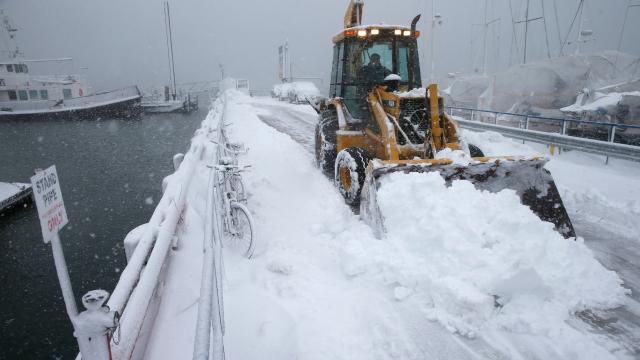Climate change is going to have a lot of unpleasant consequences. But at least those of us on the East Coast won’t face as many nasty winter snowstorms, right? Well… a new study is throwing a bit of cold water on that silver lining.
Residents of the Northeast are all too familiar with nor’easters, cold-weather cyclones that can deliver eye-popping snow totals accompanied by power outages, terrible traffic, massive school closures, and back-breaking shoveling. Research published recently in Geophysical Research Letters looked at how these and other winter snowstorms will change in a warming world.
While snowphobes might cheer the late 21st century forecast of less white stuff on the whole, the biggest and baddest storms — which frequently fall into the nor’easter bucket—are unlikely to go away.
“The idea is we’ll have less total snowstorms in the future, but when you do have a snowstorm, it’s more likely it’ll be an intense snowstorm than a weak one,” study author Colin Zarzycki, an assistant professor in Penn State’s Department of Meteorology and Atmospheric Science, told Gizmodo.
Zarycki reached this bummer conclusion by looking at 35 different climate model simulations run by the National Center for Atmospheric Research (he conducted the research while he was a project scientist there). These models are all based on the same assumptions about our future climate (in this case, a high carbon emissions scenario known as RCP 8.5) but use slightly different starting conditions that can lead to different outcomes for the weather. He then wrote an algorithm to pluck out individual snowstorms from these models and create a probability distribution of different snowy futures.
This approach is especially helpful for predicting how big, infrequently occurring storms might change, Zarycki said.
The analysis showed that although winter storms will be more likely to dump their water as rain in a warmer future, when snow does fall it could pile up even higher than it does today. That’s because warmer oceans will provide more fuel for storms, and a warmer atmosphere can hold more moisture. Overall, the study predicts the number of big winter storms to look roughly the same by century’s end.
Several experts not involved with the study said these results made sense. “The study points out the obvious, that as things warm, we are more apt to get rain rather than snow,” NCAR climate scientist Kevin Trenberth told Gizmodo in an email. “But it also points out we can still get big snows. The oceans are warming and thus can readily supply plenty of moisture. Even in a warmer world, though, we still have winter and it gets cold over land and to the North.”
MIT atmospheric scientist Kerry Emanuel also thought study’s conclusions about snowfall seemed “reasonable” but added that it’s important to consider the coastal flooding impacts of winter storms, too. Indeed, nor’easters often produce car-entombing floodwaters some extra juice.
Zarycki said factoring in the effects of storm surge was an important direction for future work. He’s also hoping to look at how shifts in population density (people moving into or out of cities) could affect future winter storm hazards.
“This looks at the big picture of snowfall, but some next generation climate models might allow us to drill down on what this means for New York City or Philly,” he said, adding that these hyper-local impacts “require really big computers.”
Bottom line for East Coasters, though? You’re going to need to keep that snow shovel on hand at least until the end of the century.
